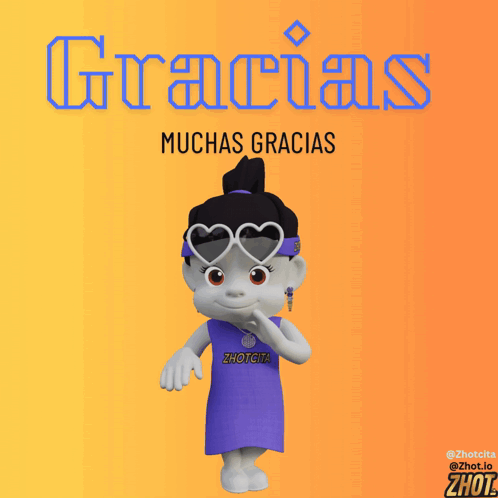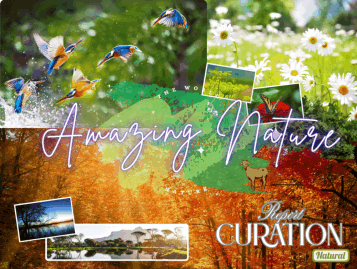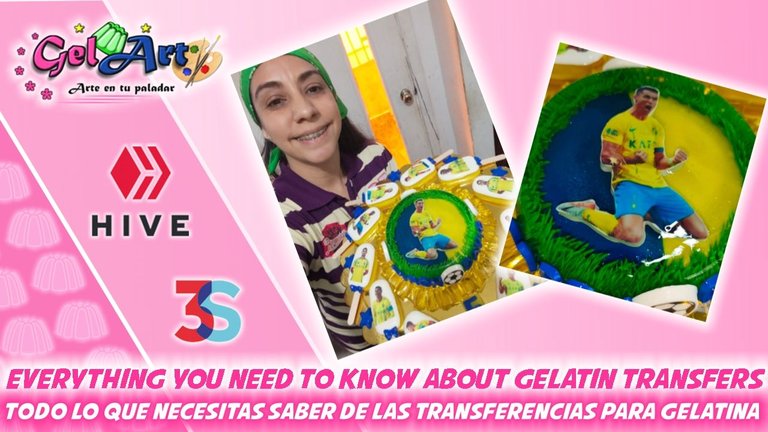
Welcome to a new video.
Bienvenidos a un nuevo video.
Hello Hello dear HIVERS, happy start of the week and very especially to my beautiful people and the most creative of the gastronomy on the web3, to all who make life in the community of @creativecuisine today I want to share some of my knowledge in the art of gelatin and tell you about the transfers in gelatin, a technique that certainly will help you to make very creative gelatin if you dare to apply it.
Hola Hola queridos HIVERS, feliz inicio de semana y muy en especial a mi gente bonita y la más creativa de la gastronomía en la web3, a todos los que hacen vida en la comunidad de @creativecuisine hoy les quiero compartir parte de mis conocimientos en el arte de las gelatinas y hablarles de las transferencias en gelatina, técnica que por cierto les ayudará a realizar gelatinas muy creativas si se atreven a aplicarla.
What are gelatin transfers?
This technique consists of transferring an image from paper to gelatin, as you could see in the video. The printed image is transferred to the gelatin leaving any design we want to place on our dessert.
It is widely used for children's gelatins since it allows us to place any doll or character we want, and they are the most requested gelatins.
You can also transfer images with photographs, for this type of images I recommend using good quality photos, preferably professional and with very good lighting, a pixelated photo, or a screenshot of a phone is not a good idea, they are not quite right.
With this technique the options are endless, the limit is the creativity and requirements of each person, we can add texts, logos and anything that can be printed can be added to our gelatins.
¿Qué son las transferencias en gelatina?
Está técnica consiste en pasar una imagen desde un papel a la gelatina, tal como lo pudieron observar en el vídeo. La imagen impresa se transfiere a la gelatina dejando plasmando en nuestro postre cualquier diseño que deseemos colocar.
Es muy utilizada para gelatinas infantiles dado que nos permite poder colocarle cualquier muñeco o personaje que deseemos, y son de las gelatinas más pedidas
También se puede transferir imágenes con fotografías, para este tipo de imágenes recomiendo utilizar fotos de buena calidad, de preferencia profesionales y con muy buena iluminación, una foto pixelada, o un capture de pantalla de un teléfono no es buena idea, no quedan del todo bien, recomiendo imágenes con buena resolución.
Con esta técnica las opciones son infinitas, el límite es la creatividad y requerimientos de cada quien, podemos agregar textos, logos y cualquier cosa que se pueda imprimir lo podemos agregar a nuestras gelatinas.
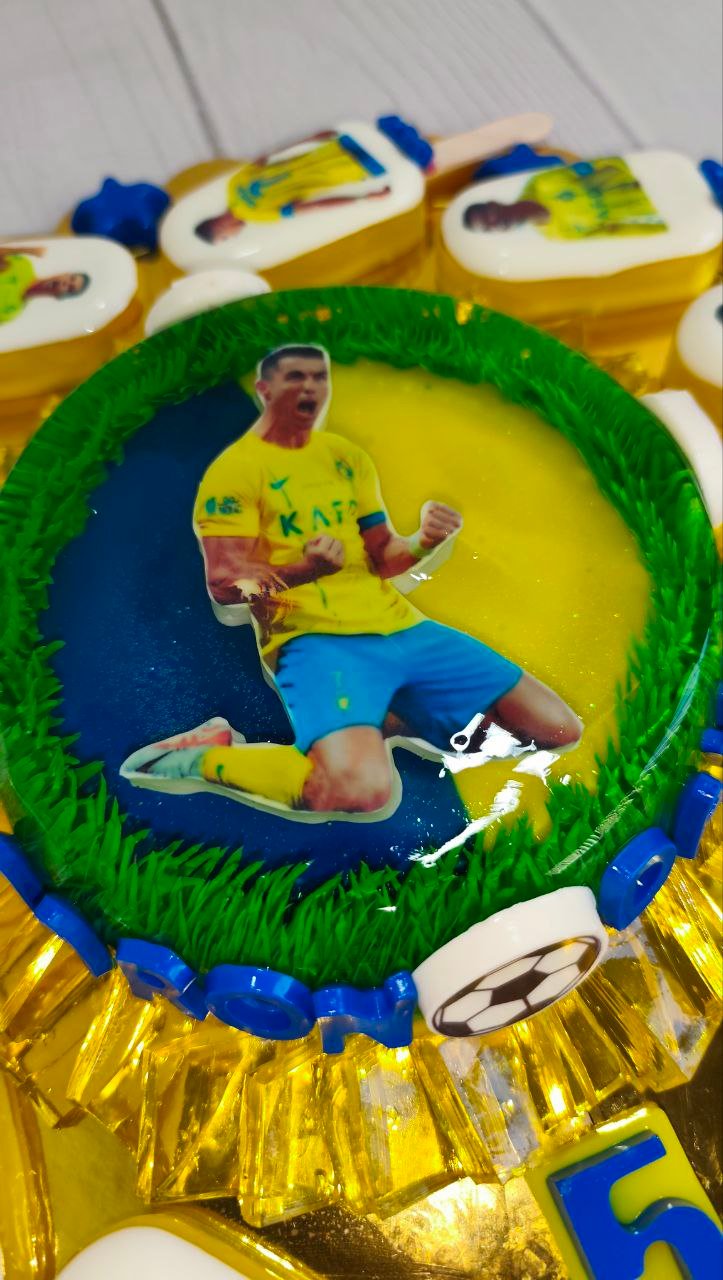
Can any printed image be used for this?
No! It is important that we use images printed with vegetable ink (edible) because it is something that we are going to eat, it is not advisable to use toxic inks and another reason is that vegetable ink gives more beautiful results.
Vegetable ink is different from normal ink and the machines with this type of edible ink require more maintenance and continuous use because they have a tendency to clog. Here in Anaco many years ago there was a store that made very good quality prints and I remember that the man lived with his hands full of ink and the printer was always clogged and he had to clean it until it worked again.
With the migration issue this man left the country and I had to buy in another place (the only one that made them here), and I remember that the prints were very bad, and the times I went I never saw problems with their printer and I have the suspicion that they did not use vegetable ink, with the prints of that place I had to leave the image for hours stuck to pass a little color, in view of this that was affecting the quality of my work and since in Anaco there were not many options I borrowed money to buy my own vegetable ink printer.
After having my vegetable ink printer I understood why there are few options hehehe I feel that it has made me go gray hairs from the bad times it gives me every time it clogs and I have had to take it to repair and change parts twice, but all in all it is worth it to ensure a good job to my customers and also an extra income for me by selling this type of printing.
I bought a new printer by MercadoLibre Epson brand that came from the beginning with vegetable ink, and the seller guaranteed me that with the continuous ink system that he used no longer clogged as much as before, and although sometimes I joke is not every day that I have to do maintenance, I think they work better when they are in cool weather or air conditioning, once I had it in a room without air conditioning and that was when I had more problems, I moved it to a room with air and it shares much better. I'll leave a picture of the model I have here below.
¿ Se pueden usar cualquier imagen impresa para esto?
No! Es importante que utilicemos imágenes impresas con tinta vegetal (comestible) por tratarse de algo que nos vamos a comer no es recomendable usar tintas tóxicas y otra razón es que la tinta vegetal da resultados más bonitos.
La tinta vegetal es diferente a la normal y las máquinas con este tipo de tinta comestible requieren mayor mantenimiento y estar en uso continuo porque tienen tendencia a taparse. Acá en Anaco estaba hace muchos años una tienda que hacía impresiones de muy buena calidad y recuerdo que el señor vivía con las manos llenas de tinta siempre se le tapaba la impresora y tenía que limpiarla hasta que le funcionaba de nuevo.
Con el tema de las migraciones este señor se fue del país y me tocó comprar en otro lugar (el único que las hacía aquí), y recuerdo que las impresiones eran muy malas, y las veces que fui nunca ví tuvieran problemas con su impresora y tengo la sospecha que no usaban tinta vegetal, con las impresiones de ese lugar tenía que dejar horas pegada la imagen para que pasara un poco de color, en vista de esto que estaba afectando la calidad de mi trabajo y dado que en Anaco no había muchas opciones pedi un dinero prestado para comprarme mi propia impresora de tinta vegetal.
Luego de tener mi impresora de tinta vegetal entendí porque hay pocas opciones jejeje siento que me ha hecho salir canas de los malos ratos que me da cada vez que se tapa y he tenido que llevarla a reparación y cambio de piezas en dos oportunidades, pero dentro de todo vale la pena para garantizar un buen trabajo a mis clientes y también un ingreso extra para mí por vender este tipo de impresiones.
Yo compré una impresora por MercadoLibre nueva de marca Epson que vino desde el inicio con tinta vegetal, y el vendedor me garantizo que con el sistema de tinta continuo que usaba ya no se tapaban tanto como antes, y pues aunque a veces me echa broma no es todos los días que me toca hacerle mantenimiento, creo funcionan mejor cuando están en clima fresco o aire acondicionado, en una oportunidad la tuve en una habitación sin aire acondicionado y fue cuando más problemas me dió, la mudé a una habitación con aire y se comparta mucho mejor. Les voy a dejar una foto del modelo que tengo acá mas abajo.
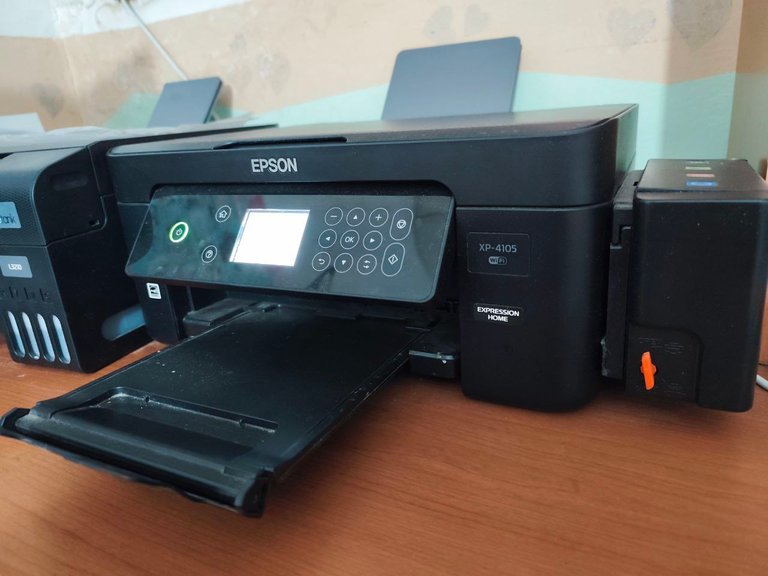
I have always bought vegetable dye from the same seller, he brought an imported one from Mexico that I think he re-bottled because it came in bottles with no brand name, but the last ones he sent me look very similar to the ones I have seen on MercadoLibre.
Yo siempre le he comprando la tinta vegetal al mismo vendedor, el traía una importada de México que creo la re-embotellaba porque venía en frascos sin nombre de marca, pero las últimas que me envió se parecen mucho a unas que he visto por MercadoLibre.
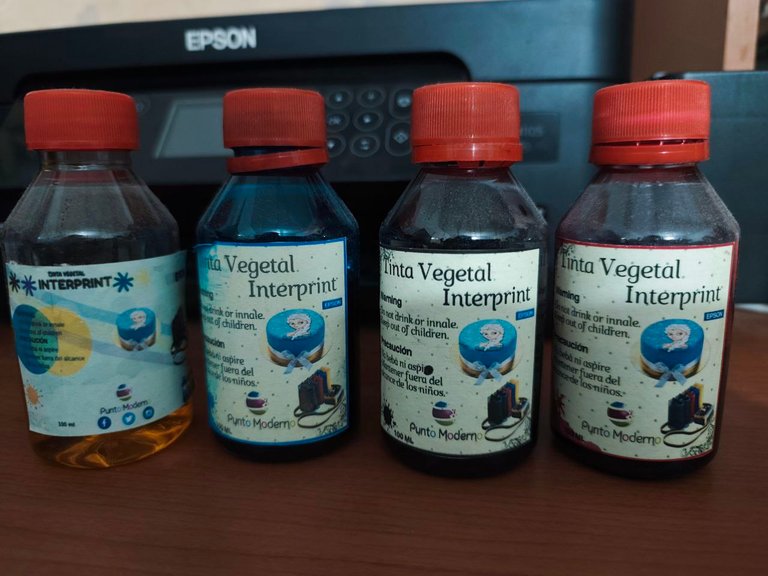
What are the types of vegetable ink prints and which one do you recommend?
There are two types of transfer prints for gelatin, or at least they are the ones I know, prints on normal sheet and on rice paper, of course both with vegetable ink, to recommend any of them is difficult, both are good if they are made in a place that makes them well, it depends on what you are looking for as an advantage, I will tell you a little of each of their advantages and disadvantages and it is up to you to decide which one to use.
Normal sheet printing with vegetable ink: this type of prints are made on Bond paper sheet, can be letter and legal type, the great advantage of these is the price because they are much cheaper than rice paper, the disadvantage is that it takes a little longer to transfer the image, but still the result is very good, the ones I used in the video were prints on normal sheet, they are the ones I use the most because they are cheaper and because sometimes I print very punctual things that don't fill a full sheet and it hurts me to leave blank space on rice paper, I live on the run and I don't always have time to put extra things, besides my computer is not the friendliest/fastest.
prints on rice paper with vegetable ink: this type of paper is a little more expensive and this is the only disadvantage, they are edible sheets but nevertheless we also remove them after transferring the image, the image transfer with this type of paper is much faster and the result is much sharper, I usually use this type of prints when I want to make the process faster.
¿Cuáles son los tipos de impresiones en tinta vegetal y cuál recomiendas?
Existen dos tipos de impresiones de transferencias para gelatina, o al menos son las que yo conozco, impresiones en hoja normal y en papel de arroz, por supuesto ambas con tinta vegetal, de recomendar alguna esta difícil ambas son buenas si son hechas en un lugar que las haga bien, depende lo que busques como ventaja, les voy a hablar un poco de cada una sus ventajas y desventajas y ya queda de decisión propia cual utilizar.
Impresiones en hoja normal con tinta vegetal: este tipo de impresiones se realizan en hoja de papel Bond, puede ser tipo carta y oficio, la gran ventaja de estas es el precio debido a que son mucho más económicas que las de papel de arroz, la desventaja es que tardan un poco más de tiempo en transferir la imagen, pero igual el resultado es muy bueno, las que utilicé en el vídeo fueron impresiones en hoja normal, son las que más uso porque son más económicas y porque suelo a veces imprimir cosas muy puntuales que no llenan una hoja completa y me da dolor dejar espacio en blanco en hojas de arroz, vivo a las carreras y no siempre me da tiempo de meter cosas extra a parte que mi computadora no es la más amigable/rápida.
impresiones en papel de arroz con tinta vegetal: este tipo de papel es un poco más costoso y está es la única desventaja, son hojas comestibles pero que sin embargo también las retiramos luego que transfiere la imagen, la transferencia de imagen con este tipo de papel es mucho más rápida y el resultado es mucho más nítido, yo suelo usar este tipo de impresiones cuando quiero hacer el proceso más rápido.
How are transfers made?
Once we have our image printed with vegetable ink, we place it on top of milk gelatin preferably, with the figure of the image facing the gelatin, that is to say that the part that has ink/image is stuck on the gelatin so that it transfers the image.
Although transparent/citric gelatin can also be used to transfer images, the color is not quite right. It is also convenient to use milk gelatin without any type of color especially if the image has colors, that the canvas to transfer the dead image is white is ideal if we want the colors to look good.
Although it is also possible to transfer image on milk gelatin with some color but the colors of the print will not be well differentiated, this can be done for prints that have for example only black color as this can be seen well on top of almost any color.
The gelatine transfers can be placed on top of complete gelatines or on top of gelatine sheets and then chop the image of the sheets for a more 3D effect, I am going to leave two gif as an illustration so you can see these two options.
¿Cómo se realizan las transferencias?
Una vez que tenemos nuestra imagen impresa con tinta vegetal, la colocamos encima de gelatina de leche preferiblemente, con la figura de la imagen viendo hacia la gelatina, es decir que la parte que tiene tinta/imagen quede pegada en la gelatina para que transfiera así la imagen.
Aunque en gelatina transparente/cítrica también se pueden transferir imágenes, no queda el color del todo bien. También es conveniente usar gelatina de leche sin ningún tipo de color en especial si la imagen tienen colores, que el lienzo para transferir muerta imagen sea blanco es lo ideal si queremos que los colores queden bien.
Aunque también se puede transferir imagen en gelatina de leche con algún color pero no se van a diferenciar bien los colores de la impresión, esto puede hacerse para impresiones que tengan por ejemplo sólo color negro ya que este puede verse bien encima de casi cualquier color.
Las transferencias de gelatinas las podemos colocar encima de gelatinas completas o encima de laminas de gelatinas y posteriormente picar la imagen de las láminas para un efecto más 3D, les voy a dejar dos gif a modo de ilustración para que vean estás dos opciones.
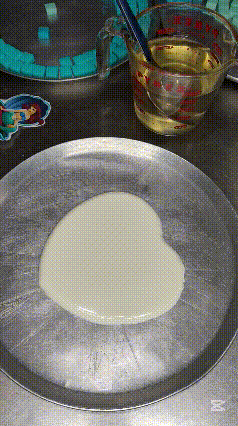 | 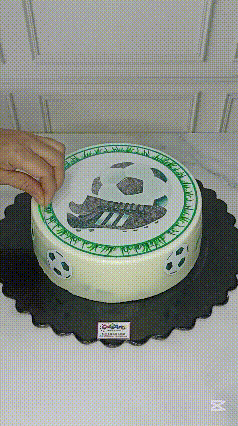 |
|---|
How long should the image be left on top of the gelatin?
The time to transfer the color depends on the type of paper being used, if it is rice paper, in 5 minutes it should have transferred completely, with normal paper at least 20 or 30 minutes, this depends on the quality of the print, if they are bad it takes hours to give an acceptable result!
¿Cuánto tiempo se deben dejar la imagen encima de la gelatina?
Para que transfiera el color el tiempo depende del tipo de papel que se esté usando, si es papel de arroz, en 5 minutos ya deben haber transferido por completo, con hoja normal al menos unos 20 o 30 minutos, esto depende de la calidad de la impresión, si son malas tardan horas en dar un resultado aceptable!.
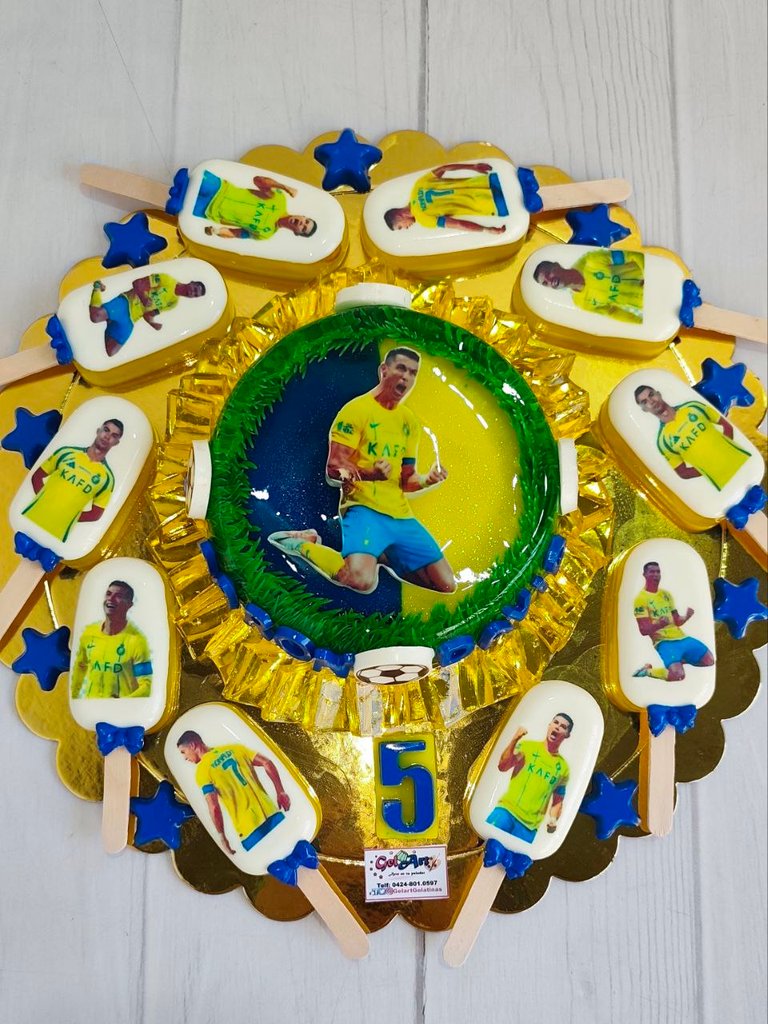 | 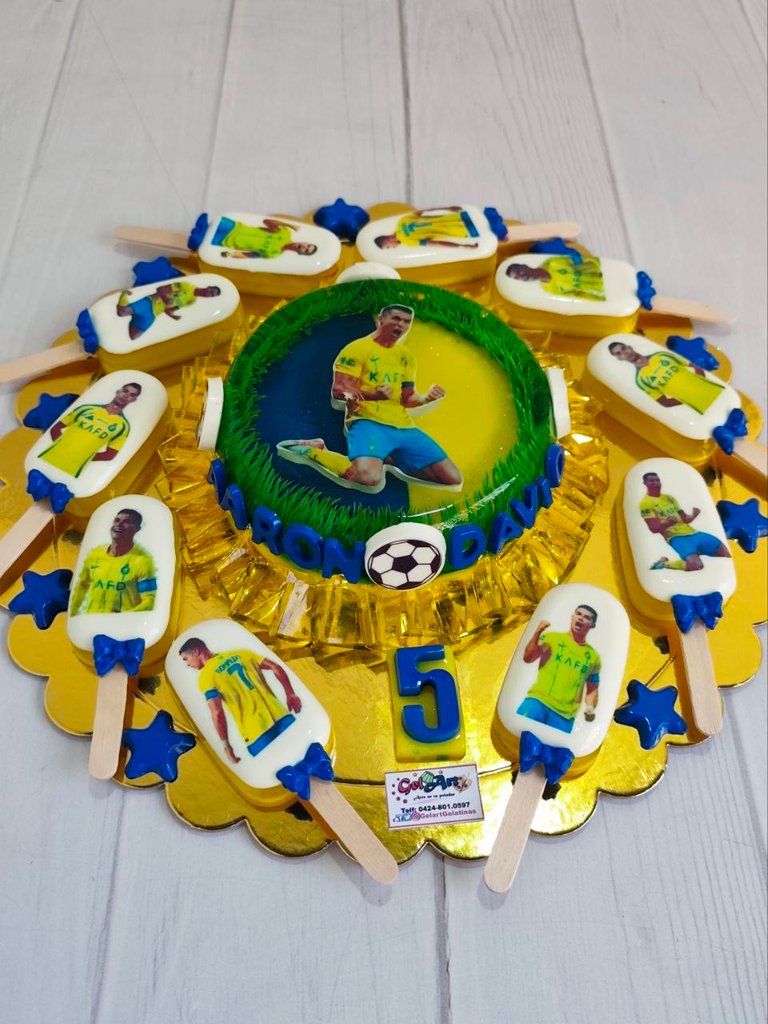 |
|---|
I leave here for the digital memory other pictures of this beautiful work, here I used transfers in normal sheet with photos of Cristiano Ronaldo, in the main one I placed it 3D style making the transfer on a sheet and in the lollipops I transferred directly on milk gelatin.
I hope you liked my post today and that this little bit of knowledge will help you to unlock a new level of creativity with jellies ♥️ and by the way if you want the recipe for milk jelly here in the following link you can see a post in which I shared the recipe.
I send you all a jelly hug 🤗 I wish you a happy, blessed and successful start of the week, thank you very much for reading me, any doubt don't hesitate to leave me your comments, see you in a next post.
Les dejo por acá para el recuerdo digital otras fotitos de este bello trabajo, acá utilicé transferencias en hoja normal con fotos de Cristiano Ronaldo, en la principal lo coloque estilo 3d haciendo la transferencia sobre una lamina y en las paletas transferí directo sobre gelatina de leche.
Espero les haya gustado mi post de hoy y que este pequeño aporte de conocimientos les sirva para desbloquear un nuevo nivel de creatividad con las gelatinas ♥️ y por cierto si quieren la receta de la gelatina de leche acá en el siguiente enlace puede ver un post en que compartí la receta.
Les mando a todos un abrazo gelatinoso 🤗 les deseo un feliz, bendecido y exitoso inicio de semana, muchas gracias por leerme, cualquier duda no duden en dejarme sus comentarios, nos vemos en una próxima publicación.
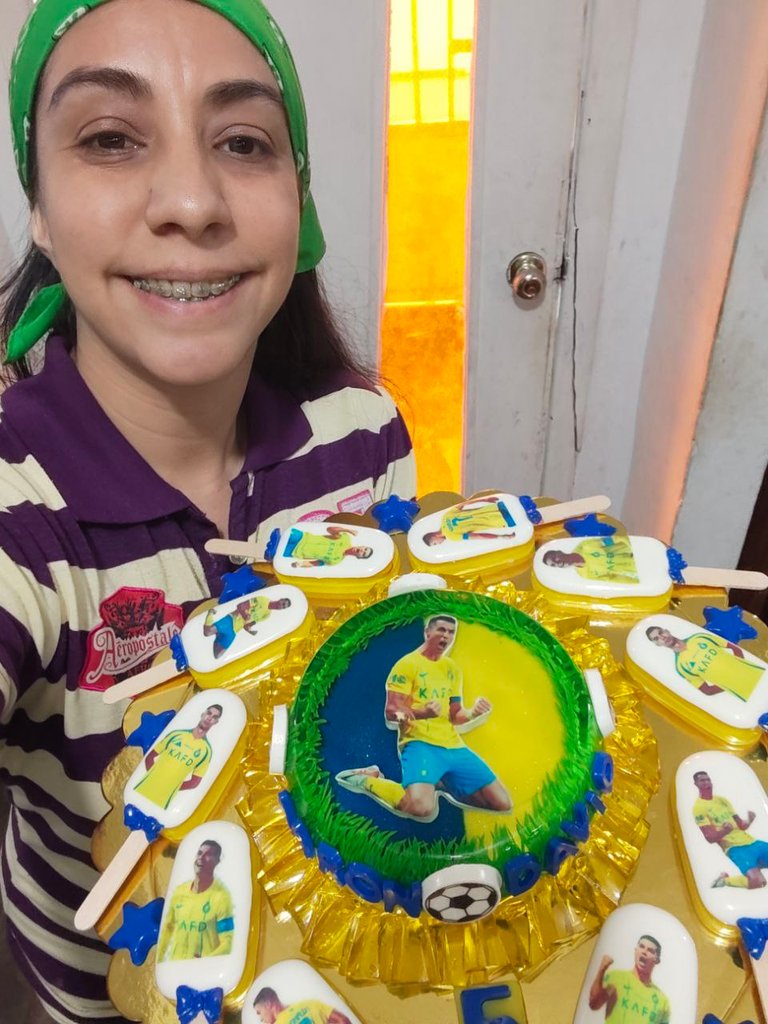
Music by FASSounds from Pixabay
▶️ 3Speak





